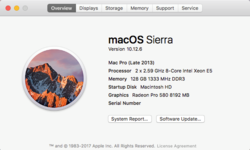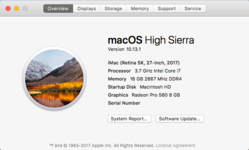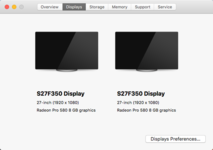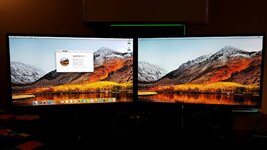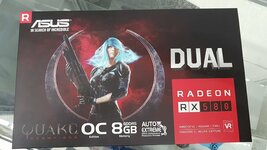- Joined
- Jul 22, 2018
- Messages
- 9,248
- Motherboard
- Supermicro X11SPA-T
- CPU
- Intel Xeon W-3275 28 Core
- Graphics
- 2xAMD RX 580 8GB
- OS X/macOS
- 13.x
- Bootloader
- OpenCore (UEFI)
- Mac
- Mac mini
- MacBook Pro
- Mobile Phone
- Android
- iOS
How to Enable AMD Graphics in macOS
An EliteMacx86 Exclusive Guide - This guide covers the implementation of supported AMD GPU on macOS. By following this guide, you'll be able to enable AMD Graphics on macOS using Clover or OpenCore Bootloader.Overview
Apple has been using a wide range of AMD Graphics Card for a long time. The good news is with the release of macOS version 10.12.6, will include the drivers for RX 470, RX 480, RX 570, and RX 580. This means from macOS 10.12.6 and future macOS versions, we don’t need to perform any kext modifications to make AMD GPUs work in the build.
With such good support for AMD GPUs, it's quite easy to get AMD graphic cards working on macOS Sierra 10.12.6 and later which requires only a few steps. The sleep/wake function also works normally without any restarts or crashes. Also, you don't need to use any helper cards or IGPU.
Before macOS Sierra version 10.12.6, it was quite difficult to get any AMD Cards working as it involved several steps to get it working with the right framebuffers which were too difficult for any beginner/new users. With this, it had a few restrictions and required a helper/secondary or IGPU(Intel HD Graphics) for the hardware acceleration.
Now you can run AMD graphics card natively without the need of installing any Drivers like NVIDIA and extra configuration. With the release of macOS High Sierra, a wide range of AMD graphics cards has been added and has better support than macOS Sierra in terms of AMD GPUs.
This method is easy to roll back and works after the update. Before using this guide, we recommend you to perform a clean installation of macOS.
Requirements
| Graphics | macOS Compatible AMD GPU |
| Kexts | Original Graphics kexts in S/L/E |
| macOS Version | OS X Lion 10.7.5 and later |
Compatibility
For more information on GPU compatibility, refer to the thread linked below.

AMD GPU Compatibility List for macOS
AMD GPU Compatibility List for macOS AMD APU Compatibility https://elitemacx86.com/threads/amd-apu-compatibility-list-for-macos.1157/ 1. Desktop Series II. Radeon X500 Series Supported Since: 10.3 Max Native Support: 10.7.5 Max Patched Support: Metal: Not Supported H.264: H.265: Not...
 www.elitemacx86.com
www.elitemacx86.com
For RX 6000 Series AMD NAVI GPU, see here

GUIDE - How to Enable AMD RX 6800, RX 6800XT and RX 6900XT on macOS Big Sur and Later
How to Enable AMD RX 6600, RX 6600XT, RX 6800, RX 6800XT and RX 6900XT Graphics on macOS Big Sur and Later An EliteMacx86 Exclusive Guide - This guide covers the implementation of AMD Navi RDNA2 GPU on macOS Big Sur and later. By following this guide, you'll be able to achieve full QE/CI on your...
 elitemacx86.com
elitemacx86.com
For AMD APU, see here

GUIDE - How to Enable AMD Integrated Graphics (APU) on macOS [Clover/OpenCore]
How to Enable AMD Integrated Graphics (APU) on macOS [Clover/OpenCore] An EliteMacx86 Exclusive Guide - This guide describes how to enable AMD APU Graphics on macOS and is applicable to both, Clover and Opencore. By following this guide, you'll be able to achieve full QE/CI on your AMD CPU with...
 elitemacx86.com
elitemacx86.com
STEP 1: Setup BIOS
The very first step is to set up BIOS to have the AMD GPU Enabled on your System. Follow the steps below to set up your BIOS for NVIDIA GPU.
1. On your target computer, boot to BIOS. Refer to your user manual for the BIOS Key
2. Set the following parameters as shown.
| Settings | Value | Notes |
|---|---|---|
| Initial PCIe Output Display | PCIe/Auto/Enabled | Depending on your System's BIOS, use one of the Values available |
| Intel Processor Graphics | Disabled |
NOTES:
- The above settings are for Graphics only. See BIOS Settings for more information.
- If your system does not have any of the above settings in BIOS, ignore such settings.
- If your BIOS has a CSM option, disable it.
- If your BIOS has PCI ROM Priority, set it to UEFI/UEFI ROM.
- If your BIOS has Legacy Option ROMs, set it to UEFI/UEFI Only.
3. Save & Exit Setup
STEP 2: Remove Outdated Kexts, Injections, and ACPI Renames
Once you have set up the BIOS, the next step is to remove the kexts, injections, and ACPI renames that can interfere with the Graphics implementation. To remove such, follow the steps below.
Kexts Removal
If you're using any of these kexts listed below, it is recommended to remove them. See notes below.
1. Mount your ESP
2. Remove the following kexts.
- IntelGraphicsFixup.kext
- NvidiaGraphicsFixup.kext
- CoreDisplayFixup.kext
- Shiki.kext
- IntelGraphicsDVMTFixup.kext
- AzulPatcher4600.kext
- AppleBacklightFixup.kext,
- FakePCIID_Intel_HD_Graphics.kext
- FakePCIID_Intel_HDMI_Audio.kext
- FakePCIID.kext
NOTES:
|
Clover Properties and Injections
If you're using Clover, you need to disable Clover properties and injections.
1. Mount your ESP
2. Open your config.plist and disable and/or remove the following from their respective sections
Disable DSDT Fixes
The DSDT fixes can be disabled in
Acpi>Fixes section.- AddHDMI
- FixDisplay
- FixIntelGfx
- AddIMEI
- FixHDA
- AddPNLF
The Fake IDs can be disabled in the
Devices>Fake ID section.- ATI
- IntelGFX
- NVidia
- IMEI
The injection properties can be disabled in the
Devices>Properties section.- Inject
- UseIntelHDMI
- HDMIInjection
- SetIntelBacklight
- SetIntelMaxBacklight
The Graphics injection can be disabled in the Graphics section
- ATI
- Intel
- NVidia
The ig-platform-id can be removed in the Graphics section
ACPI Renames
If you're using any ACPI renames, you'll need to disable or delete the ACPI renames as these can conflict with WhateverGreen's automatic renames.
1. Mount your ESP
2. Open your config.plist and remove the following ACPI renames. For Clover, it's in
Acpi>DSDT>Patches section, and for OpenCore, it's under ACPI>Patch section.- GFX0 to IGPU
- PEGP to GFX0
- HECI to IMEI
- MEI to IMEI
- HDAS to HDEF
- B0D3 to HDAU
The next step is to add the required kexts to enable AMD Graphics. WhateverGreen doesn't work standalone. WhateverGreen and Lilu are needed together to work in conjunction in order to enable AMD Graphics and prevent any errors.
1. Download WhateverGreen and Lilu from the downloads section of this forum.
2. Mount your ESP.
For Clover:
If you're using Clover, copy both the kexts to
EFI/Clover/Kext/OthersFor OpenCore:
If you're using OpenCore, copy both the kexts to
EFI/OC/Kexts. You'll also need to add the kext entries in the Kernel section of your config.plist.NOTES:
|
STEP 3: Restart your System
After performing all the above steps, restart your system for the applied changes to take effect.
Verifying your Card
Look for the information of your card under About this Mac and verify the VRAM. For more information about your Card, navigate to System Information and navigate to Graphics/Displays Tab.
NOTES:
|
Sample Attachment
The AMD RX580 from Sapphire and ASUS are used as examples in this guide.
Credits :
vit9696
Attachments
Last edited:

